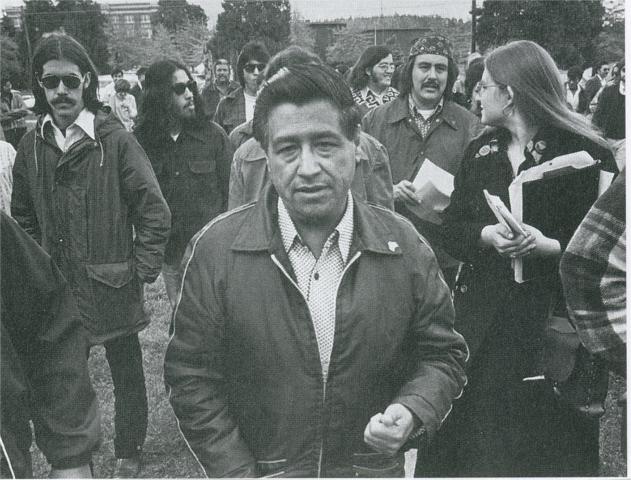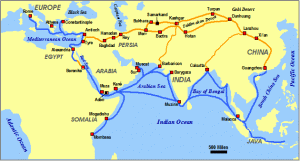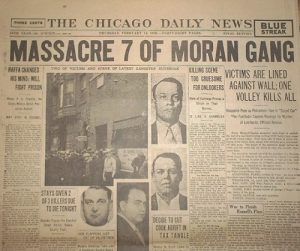Cesar Chavez was born on a scorching hot day near Yuma Arizona on March 31st, 1927 to Mexican-American immigrant parents in a small adobe home. His whole family farmed the land and they faced the struggles of farm life constantly. Unfortunately, they ended up losing the farm and their home 11 years later during the latter years of the Great Depression and the family ended up working as migrant farmers.1 Cesar’s Father, Librado Chávez, lost the house from a dishonest deal that forced their move to California. To explain further, Librado agreed to clear 80 acres of land in exchange for 40 acres that were connected to their small adobe home but upon clearing the land, the deed was sold to another land developer instead. When Librado approached a lawyer for legal help, he advised him to take out a loan which he did and they eventually foreclosed on the loan due to their inability to pay off the interest. At just ten years old Chavez came to learn the hard lessons of backbreaking work in the fields and the desperation of homelessness that a lot of migrant farmers faced still in the 20th century. 2
Life as a migrant farm worker in the first half of the 20th century was grueling, tough, dangerous, and miserable. Most of them were nomadic, moving from field to field for each harvest without somewhere to call “home”. For context, a lot of farmers were subjected to terrible sanitary quarters and lacked access to healthcare which meant constant typhus outbreaks. Somewhat unrelated to health, they were also confronted with overt racism embedded in the regulations and institutions.3
The United States implemented in the early 20th century the Bracero program because the farmers who migrated added to the influx of Mexican American farm workers in turn decrease the demand for farm hands which lowered everyone’s wages. After the Great Depression, big farming corporations argued that the United States experienced a labor shortage due to World War II, and was not able to meet demands for agricultural products. This prompted the inception of the Bracero Program that worsened working conditions for Mexican American farmers already living in the U.S. The wages were low and the working conditions harsh, all while growers benefited from cheap and plentiful labor.4 In addition to this, the same growers hindered attempts by farmers to unionize by threatening them with the cheap and plentiful labor from across the border.5 Organizing farmers was essential to securing fair and livable wages but the corporations knew this and frequently brutally disbanded any group that tried to protest.
Chavez and his family experienced absolute poverty and lack of sanitation while following the harvests after losing their house in Yuma, Arizona. Chavez could no longer attend school after 8th grade when his father died from a stroke. Chavez had to work in the fields picking fruit or vegetable depending on the harvest. He and his family still managed to save enough money to buy a cottage in San Jose, California. Chavez later joined the United States Navy to fight in WWII and came back to marry Helen Fabela in 1948. Chavez struggled to leave behind his migrant conditions.
A pivotal time in Chavez’s life came from his time with the Community Service Organization (CSO). At its start, the CSO was a prominent Latino civil rights organization that mainly focused on issues such as voter registration and organized voting drives all across California. Fred Ross, one of the co-founders of the CSO later invited Chavez to become part of the group which proved to be a turning point in Chavez’s life. After being successful in Los Angeles, Ross had plans to expand the CSO to cities around California. His first stop was in San Jose. One evening in 1952 after farming in apricot orchids, Chavez crossed paths with Fred Ross through a mutual friend and they soon became acquainted. At the time, Chavez had been through a lot. So when Fred Ross pitched him the idea of the CSO, he was intrigued.

Chavez took part in the movement and lead projects that the CSO was coordinating mainly by giving speeches concerning workers’ rights and the importance of voting. Before this, he had never done any organizing of any sort, so joining the CSO and later leading it inspired his entrance into organizing farm workers.6 Events like these were small but impactful in spreading the awareness of voting which helped push for legislation such as the Voting Rights Act of 1965. Soon after leading many organized voter registration drives, Chavez rose to the rank of National Director of the CSO. A couple of years later, Cesar Chavez wanted to move the CSO towards issues affecting farm workers specifically, but the CSO was reluctant and non-responsive to Chavez’s wishes. Specifically, he wanted to unionize farm workers starting in California, but the CSO declined his proposal. His experience as a farm worker drove his ambitious need to unionize farm workers to stop the explaoitation farm workers had to go through.
Xenophobic sentiments ran especially high during this time and many Mexican Americans, especially farmers or day laborers who came through the Bracero Program experienced discrimination and neglect from the government, Jose Bracamonte states, “…even in the face of expressly secured rights, extensive human rights violations occurred to both braceros and undocumented workers. In 1959, the American Committee for the Foreign-Born citizens submitted a petition to the U.N. General Assembly that purported to document that the treatment of Mexicans in the United States violated the Universal Declaration of Human Rights…it went on to observe: The difficulties suffered by the bracero reflect the problems faced by the average Mexican-American …. Mexican-American communities in all parts of the country … are kept in a state of permanent insecurity by discrimination, segregation, raids, and (sic) arrests, and repeated deportation drives.”7 Despite the contracts and promised protection, in practice, many Mexican American farm workers (and Mexican Americans generally) experienced harsh and unreasonable working conditions that violated rights promised in the Universal Declaration of Human Rights. Chavez knew that he needed to do something about this.

In 1962, Chavez resigned from the CSO and useed his life savings ($1,200) to start the National Farm Workers Association (NFWA) in Delano California after they refused to support his idea of starting a union for farmers.8 Chavez built on the organizing tactics he learned from Fred Ross and the CSO to recruit farmers into the Union. To illustrate how difficult it was to run the NFWA financially, out of the 1,200 of the members he had recruited, only about 200 hundred of them could afford to pay their dues.9 The NFWA functioned as a union for farm workers to negotiate salaries and working conditions but Chavez along with Dolores Huerta, who served as Vice-President, wanted to extend further than that. They understood that to be successful they had to invest in farm workers’ families and improve their overall lives. On September 30, 1962, the NFWA called their first meeting at an abandoned theater and officially elected Chavez as their President. It was here where they unveiled the iconic red flag with the black eagle.10
This was an important feat when it came to unionizing farm workers considering the difficulties that farmers faced in the past when trying to unionize. Throughout history, the idea of farmers unionizing had always largely been a failure, for example, in 1903, the American Federation of Labor (AFL – which in 1955 merged into the AFL-CIO) reportedly neglected the calls from Japanese and Mexican farm workers to unionize. Later, acts like the Bracero program (which notably Dolores Huerta played a part in repealing) tried to guarantee Mexican Americans decent workable and living conditions but to no avail. The program was largely a failure when it actually came to securing the rights of these farmers, as mentioned earlier.11 Up until the NFWA (later UFW), no union that intended to represent and fight for the rights of farmers had ever succeeded. Chavez knew when he arrived at Delano to start the NFWA, he needed to educate people about the history of agriculture and past attempts to create unions for farm workers. It was with this in mind, that he felt he could convince them of the importance of unionizing at the heart of a service organization. Arguably, a primary reason it succeeded was that he took the model of the CSO and applied it to issues that affected Mexican Americans beyond voter registration, i.e, fair wages, and working conditions. 12
On September 8, 1965, a mostly Filipino group called the Agricultural Workers Organizing Committee (AWOC) organized a strike against grape growers in and around Delano, California as a way to highlight the exploitation of the grape cutters. The NFWA soon joined the strike a week later and it became a turning point for them as they ended up later merging with the AWOC and turn into the United Farm Workers (UFW). This became Chavez’s greatest accomplishment yet. He had put in a lot of the leg work (literally) to get farmers to join his union, neglected a lot of unpaid union dues, and risked his life savings to get to this point. The strike is now known as the famous Delano Grape Strike. It lasted five years, and it severely changed the California farming industry and corporations. Chavez drew from the great activists like Mahatma Gandhi and Martin Luther King Jr. and used what many considered his favorite “weapon”, the boycott. He announced the first boycott on a company called Schenley Industries, Inc. who used grapes grown from Delano to produce some of their liquor products. He chose 13 cities across the U.S to organize boycotts and recruited teams of people who had no experience organizing boycotts. Chavez took the boycott tactic from events that had happened in the U.S in the previous decade, notably, the boycotts of Montgomery, Alabama organized in part by Dr. Martin Luther King.13

The other two notable events throughout the Delano Grape Strike that characterized Chavez’s legacy and commitment to non-violent protests were his 300-mile march from Delano to Sacramento, and his 25 days water-only fast. The 340-mile march was conducted roughly six months after the initial strike that kicked off the Delano Grape strikes. It lasted 25 days, and they stopped in 25 different towns. Rallies were held at every stop and people joined the march throughout. The march grew from 77 people at the start to hundreds of thousands. They were met with police in some cities, and roadblocks (figurative and literal) towards the capital.14

Members of the UFW came to grow impatient. The strikes and boycotts seemed not to be doing as much damage to the corporations who buy grapes as they had initially thought. This was largely due to the fact that there was still plentiful labor available, in the U.S and across the border. There were reportedly some members who wanted to resort to violence and riots, but Chavez was committed to the non-violent protests. In the midst of chaos, Chavez decided that he should partake in a 25 day water-only fast. This challenged him mentally, spiritually, and physically, as well as his commitment to non-violent protests. After the grueling 25 days were over on March 10, 1968, Robert Kennedy attended the ceremony to pay his respects. This was extremely impactful and a big moment for farm workers and the UFW. In an impromptu speech at Solidarity house in Lansing, Michigan in 1967, Chavez stated, “The growers [in Delano] were paying then from $1.10 to $1.15 an hour. We were demanding $1.40, recognition, and a written contract.15
Chavez’s experience growing up as a migrant farmer allowed him to realize the harshness and inhuman treatment that they had to endure. Organizing with the CSO influenced him and showed him the value and merit behind community service organizing. Soon enough, it clicked, and Chavez knew that for farmers in the south and southwest to gain any leverage against the large corporations who owned the farms they needed to build a union on the foundation of other necessary services for their community. He made it his mission to represent farmers who needed to gain leverage over these large corporations of growers and farm owners. Inspired by the legacies of non-violent protesters such as Mahatma Gandhi and the civil rights movement leader Rev. Dr. Martin Luther King Jr., Chavez championed the non-violent protests and boycott resolving the Delano grape strike. He also risked his mental and physical health by sustaining a 25-day water-only hunger fast and leading a 250-mile march. Many others who fought at his side, have continued the struggle for progress since he passed in 1993.
- Cesar Chavez Foundation. “About Cesar Chavez.” Accessed September 20, 2020. https://chavezfoundation.org/about-cesar-chavez/ ↵
- César Chávez, Accessed September 20, 2020, http://www.laits.utexas.edu/jaime/cwp2/ccg/corridos_de_cesar_chavez.html ↵
- Natalia Molina, “Borders, laborers, and racialized medicalization Mexican immigration and US public health practices in the 20th century,” American Journal of public health (2011): 1024-31. ↵
- Bracero History Archive. Accessed September 29, 2020. http://braceroarchive.org/about. ↵
- Oscar Castañeda Rosales, “Mexican-American Struggles to Organize”, Accessed October 18, 2020. https://depts.washington.edu/civilr/farmwk_ch5.htm ↵
- Gabriel Thompson, “America’s Social Arsonist: Fred Ross and Grassroots Organizing in the Twentieth Century“. 109-117. ↵
- Jose Bracamonte, Human Rights, Sovereignty, and the Migration of Mexican Workers. (111-121). ↵
- Maureen, Pao, “Cesar Chavez: The Life Behind A Legacy Of Farm Labor Rights”. Accessed October 1, 2020. https://www.npr.org/2016/08/02/488428577/cesar-chavez-the-life-behind-a-legacy-of-farm-labor-rights ↵
- Randy, Shaw, Beyond the Fields: Cesar Chavez, the UFW, and the Struggle for Justice in the 21st Century. (Berkeley: University of California Press, 2008). ↵
- Roger Bruns, “Encyclopedia of Cesar Chavez: The Farm Workers’ Fight for Rights and Justice.” Santa Barbara: Greenwood. 244. ↵
- Randy Shaw, Beyond the Fields: Cesar Chavez, the UFW, and the Struggle for Justice in the 21st Century. (Berkeley: University of California Press, 2008). ↵
- Cesar Chavez, Richard Jensen, John C. Hammerback, The Words of César Chávez. (College Station: Texas A&M University Press, 2002) 3 ↵
- Roger A. Bruns, “Encyclopedia of Cesar Chavez: The Farm Workers’ Fight for Rights and Justice.” Santa Barbara: Greenwood. 244 ↵
- Roberto Bustos, “The March to Sacramento” Accessed on October 1, 2020. https://libraries.ucsd.edu/farmworkermovement/wp-content/uploads/2012/05/THE-MARCH-TO-SACRAMENTO.pdf” ↵
- Cesar Chavez, Richard Jensen, John C. Hammerback, The Words of César Chávez. (College Station: Texas A&M University Press, 2002)25 ↵



6 comments
Carlos Cortes
Hello Eric this is a wonderful that truly highlighted the amazing and incredible life of Cesar Chavez as well as the impact and contributions he had to all the field workers in the US. In my opinion it is very interesting to compare this to the civil rights movements lead by Martin Luther King, they were fighting for a very similar cause and used very similar techniques to get the results that they wanted.
Andres Garcia
Eric, this article wonderfully depicts the inspiring life of Cesar Chavez! His work profoundly improved the livelihood of many Mexican- Americans farmers and the community as a whole. In the context of nations in transitions, Cesar Chavez contributed to an economic change within the United States. I found your depiction of the bracero program very interesting as I learned about it as a successful program that helped so many Mexicans find a job but get a chance at becoming US citizens. The implications it would have on people already in that industry never came to mind.
Lucia Herrera
hello, I really enjoyed reading this article. It was very informative and I did not not know all what Cezar Chavez did for the Mexican and Mexican American people of America. It is inspiring that he did so much starting with so little and such a hard life. It is great to hear about the peaceful protest he held to have the people heard. Cezar Chavez definitely needs more recognition in history classes in America.
Andrea Salas
Hi Eric ! This is a very interesting and well written article. It’s very inspiring how Cesar Chavez impacted farm workers rights. It’s very unfortunate that he learned about the backbreaking work in the fields at just 10 years old. It was really cool reading about how being part of the community service organization was a big turning point for Chavez. It was when he became integrated and started to lead projects of the organization. Another important legacy he left behind was the nonviolent protests.
Paul Garza
Hello Eric, this was a very informational article on Cesar Chavez and his impact on farm workers rights. I like that you include and describe in detail the amount of work and sacrifice that it took for Cesar to have an impact. It was really cool to read that Cesar Chavez utilized tactics like boycotting and peaceful protest that he drew from Ghandi and MLK. Although Cesar Chavez was not perfect and had a negative perspective on undocumented workers there is no doubt that he had a big impact on Mexican-americans and farm workers rights. I like really enjoyed this article as it is relevant today because farm workers who were essential workers during lockdowns in 2020 continue to be essential workers for this country and deserve more rights and better conditions.
Camryn Blackmon
Hi Eric, your article had some excellent and in-depth highlights on the life and contributions of Cesar Chavez. From your article, it is evident that the impact of Cesar Chavez’s work on Mexican-Americans’ lives is important. Although Cesar Chavez is a very complicated figure with his views on immigrants, how you described his impact on farmworker rights and unions is very significant and relevant to agricultural workers’ conditions during COVID-19.